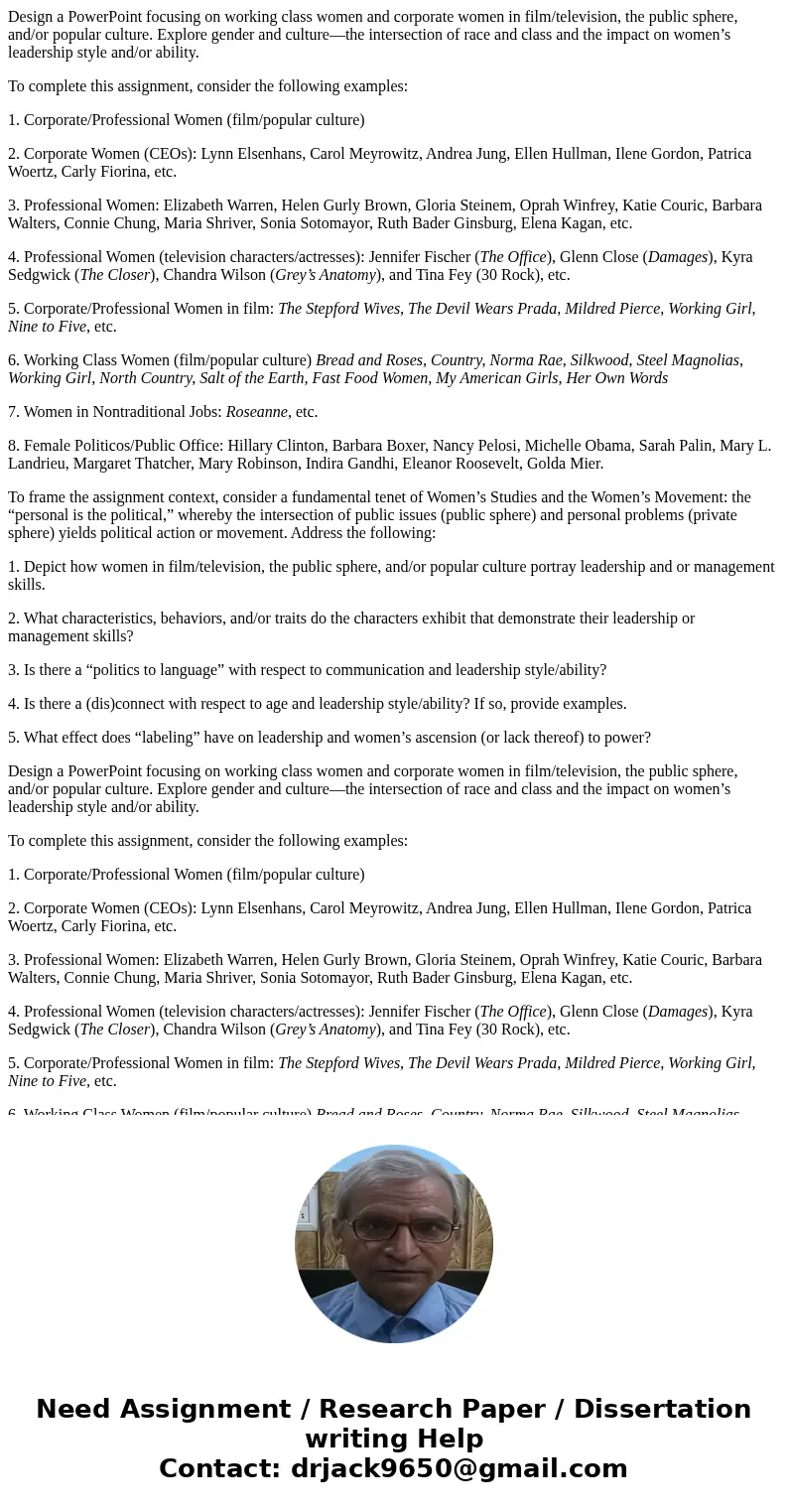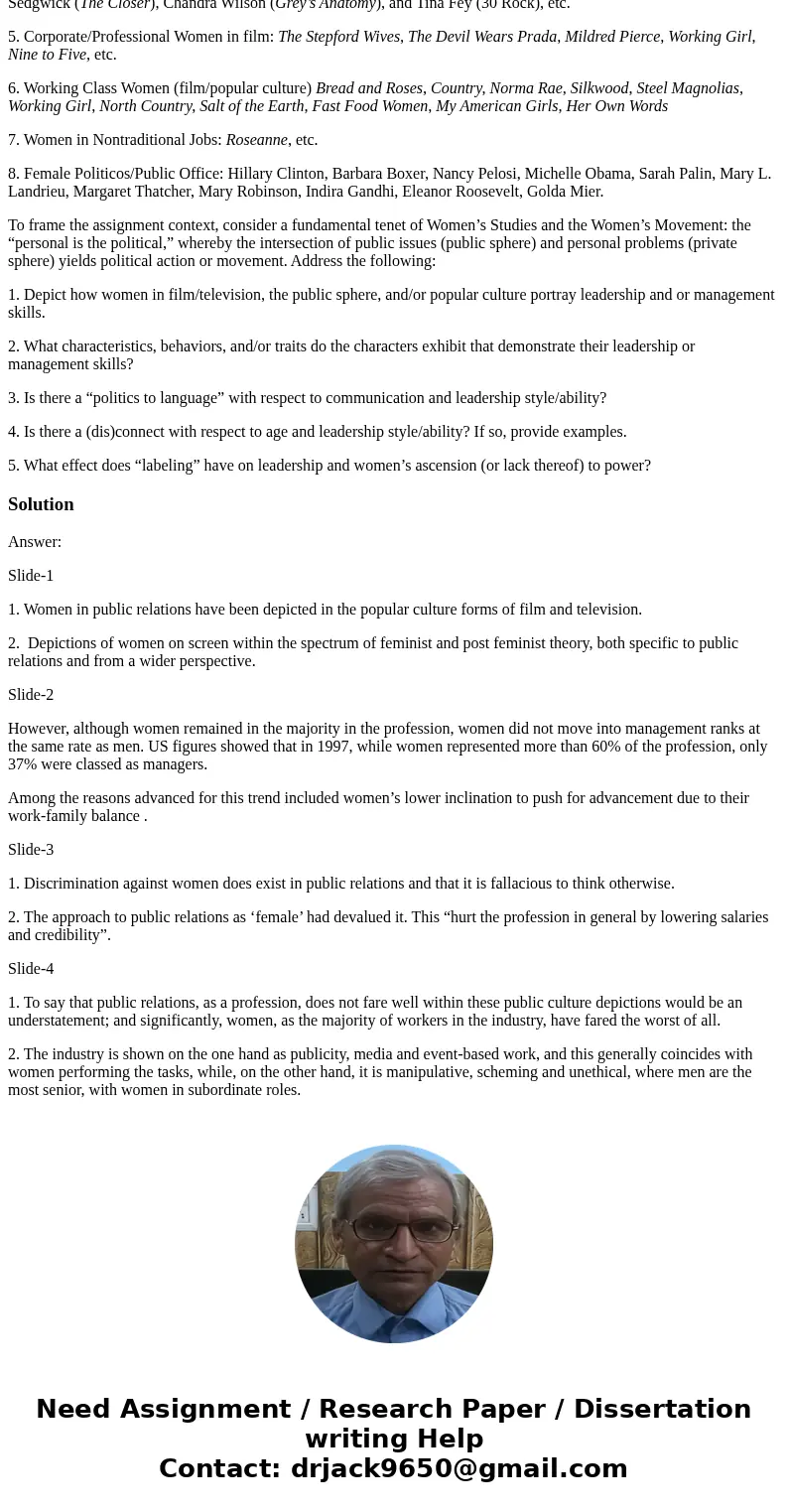Design a PowerPoint focusing on working class women and corp
Design a PowerPoint focusing on working class women and corporate women in film/television, the public sphere, and/or popular culture. Explore gender and culture—the intersection of race and class and the impact on women’s leadership style and/or ability.
To complete this assignment, consider the following examples:
1. Corporate/Professional Women (film/popular culture)
2. Corporate Women (CEOs): Lynn Elsenhans, Carol Meyrowitz, Andrea Jung, Ellen Hullman, Ilene Gordon, Patrica Woertz, Carly Fiorina, etc.
3. Professional Women: Elizabeth Warren, Helen Gurly Brown, Gloria Steinem, Oprah Winfrey, Katie Couric, Barbara Walters, Connie Chung, Maria Shriver, Sonia Sotomayor, Ruth Bader Ginsburg, Elena Kagan, etc.
4. Professional Women (television characters/actresses): Jennifer Fischer (The Office), Glenn Close (Damages), Kyra Sedgwick (The Closer), Chandra Wilson (Grey’s Anatomy), and Tina Fey (30 Rock), etc.
5. Corporate/Professional Women in film: The Stepford Wives, The Devil Wears Prada, Mildred Pierce, Working Girl, Nine to Five, etc.
6. Working Class Women (film/popular culture) Bread and Roses, Country, Norma Rae, Silkwood, Steel Magnolias, Working Girl, North Country, Salt of the Earth, Fast Food Women, My American Girls, Her Own Words
7. Women in Nontraditional Jobs: Roseanne, etc.
8. Female Politicos/Public Office: Hillary Clinton, Barbara Boxer, Nancy Pelosi, Michelle Obama, Sarah Palin, Mary L. Landrieu, Margaret Thatcher, Mary Robinson, Indira Gandhi, Eleanor Roosevelt, Golda Mier.
To frame the assignment context, consider a fundamental tenet of Women’s Studies and the Women’s Movement: the “personal is the political,” whereby the intersection of public issues (public sphere) and personal problems (private sphere) yields political action or movement. Address the following:
1. Depict how women in film/television, the public sphere, and/or popular culture portray leadership and or management skills.
2. What characteristics, behaviors, and/or traits do the characters exhibit that demonstrate their leadership or management skills?
3. Is there a “politics to language” with respect to communication and leadership style/ability?
4. Is there a (dis)connect with respect to age and leadership style/ability? If so, provide examples.
5. What effect does “labeling” have on leadership and women’s ascension (or lack thereof) to power?
Design a PowerPoint focusing on working class women and corporate women in film/television, the public sphere, and/or popular culture. Explore gender and culture—the intersection of race and class and the impact on women’s leadership style and/or ability.
To complete this assignment, consider the following examples:
1. Corporate/Professional Women (film/popular culture)
2. Corporate Women (CEOs): Lynn Elsenhans, Carol Meyrowitz, Andrea Jung, Ellen Hullman, Ilene Gordon, Patrica Woertz, Carly Fiorina, etc.
3. Professional Women: Elizabeth Warren, Helen Gurly Brown, Gloria Steinem, Oprah Winfrey, Katie Couric, Barbara Walters, Connie Chung, Maria Shriver, Sonia Sotomayor, Ruth Bader Ginsburg, Elena Kagan, etc.
4. Professional Women (television characters/actresses): Jennifer Fischer (The Office), Glenn Close (Damages), Kyra Sedgwick (The Closer), Chandra Wilson (Grey’s Anatomy), and Tina Fey (30 Rock), etc.
5. Corporate/Professional Women in film: The Stepford Wives, The Devil Wears Prada, Mildred Pierce, Working Girl, Nine to Five, etc.
6. Working Class Women (film/popular culture) Bread and Roses, Country, Norma Rae, Silkwood, Steel Magnolias, Working Girl, North Country, Salt of the Earth, Fast Food Women, My American Girls, Her Own Words
7. Women in Nontraditional Jobs: Roseanne, etc.
8. Female Politicos/Public Office: Hillary Clinton, Barbara Boxer, Nancy Pelosi, Michelle Obama, Sarah Palin, Mary L. Landrieu, Margaret Thatcher, Mary Robinson, Indira Gandhi, Eleanor Roosevelt, Golda Mier.
To frame the assignment context, consider a fundamental tenet of Women’s Studies and the Women’s Movement: the “personal is the political,” whereby the intersection of public issues (public sphere) and personal problems (private sphere) yields political action or movement. Address the following:
1. Depict how women in film/television, the public sphere, and/or popular culture portray leadership and or management skills.
2. What characteristics, behaviors, and/or traits do the characters exhibit that demonstrate their leadership or management skills?
3. Is there a “politics to language” with respect to communication and leadership style/ability?
4. Is there a (dis)connect with respect to age and leadership style/ability? If so, provide examples.
5. What effect does “labeling” have on leadership and women’s ascension (or lack thereof) to power?
Solution
Answer:
Slide-1
1. Women in public relations have been depicted in the popular culture forms of film and television.
2. Depictions of women on screen within the spectrum of feminist and post feminist theory, both specific to public relations and from a wider perspective.
Slide-2
However, although women remained in the majority in the profession, women did not move into management ranks at the same rate as men. US figures showed that in 1997, while women represented more than 60% of the profession, only 37% were classed as managers.
Among the reasons advanced for this trend included women’s lower inclination to push for advancement due to their work-family balance .
Slide-3
1. Discrimination against women does exist in public relations and that it is fallacious to think otherwise.
2. The approach to public relations as ‘female’ had devalued it. This “hurt the profession in general by lowering salaries and credibility”.
Slide-4
1. To say that public relations, as a profession, does not fare well within these public culture depictions would be an understatement; and significantly, women, as the majority of workers in the industry, have fared the worst of all.
2. The industry is shown on the one hand as publicity, media and event-based work, and this generally coincides with women performing the tasks, while, on the other hand, it is manipulative, scheming and unethical, where men are the most senior, with women in subordinate roles.


 Homework Sourse
Homework Sourse